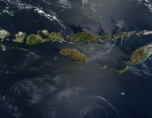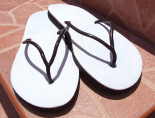Level of surfing
Evolved
Quality of surf
Very Good
Call code
670
Net code
tl
Area
15410
Coastline
706 km
Climate
tropical; hot, humid; distinct rainy and dry seasons
Hazards
Cyclones, Extreme Heat, Difficult Access, Coup / Civil Unrest
Best Months
May - August
Population
947000
Currency
United states Dollar (USD)
Time Zone
(UTC+9)
Special Requirements
Private Beaches, Special Pass / Permits, Lengthy VISA Process, Non tourist Friendly
surfing

NASA: Timor Leste and the Sunda Strait; 2005
A pitching deck, the creak of well worn timbers, the cracking of sail and canvas...tied to the mast. Things have changed a little I guess from when Jack London and Josef Conrad wrote their haunting Pacific infused epics but it hasnt changed everythwhere. There are corners of this earth where that mythos still holds true, and most of those corners are here in the South Pacific.
The main source of swell here is from the intense lows that circle the earth south of Australia, these lows spin off northwards with blessed regularity, peppering the entire region with generous SE to SW groundswell from March to September. Australia and New Zealand see the bulk of these swells. These countries cast a very tall shadow across the rest of the Pacific and hence many other islands in their wake can suffer from swell difusion. December to February is cyclone season. Unpredictable cells can deliver swell in a 360 radius, lighting up rarely breaking reefs and points facing every conceivable direction.
The South Pacific trade winds are some of the most consistent in the world, generally from the East with slight seasonal variation. This is the largest Ocean on the planet and these winds easily generate regular rideable swell. Onshore conditions can be a problem on east facing coastlines but peeling yourself out for an early surf will usually bring some relief.
In the North Pacific it is the intense lows descending from the Aleutians that deliver NE to NW swells from October to March. Hawaii is ideally placed to make best use of this energy but other coastlines in the region have their own less publicised and far less crowded gems.
Jun to October also sees rarer hurricane swell radiate out from southern Mexico. This energy is often felt right throughout Polynesia. With so many energy vectors at work it is very hard not to find a wave.
Places such as Timor Leste that offer rideable options on every coast will ensure that regadlesss of the conditions, somewhere there will be a wave. In fact quite often there will be a very good one.
what to pack

Flashdance: A pair of very simple Moroccan flip flops called "Cabjuks"; 25 May 2007
Make sure you pack according to the season.
As usual, bring all medical things u need with you, as in some remote parts of the country it can be difficult to get them. Bring your own anti-septic hand-showerstuff, because the toilets are not always very clean.
Sunglasses and protective sun lotion, as well as a good repellent. All the gear if you plan to camp: a good sleeping bag and tent that are good for very low temp; special gas container u can use for heating food and water; a sturdy backpack or a cargo pack with a good daypack.






